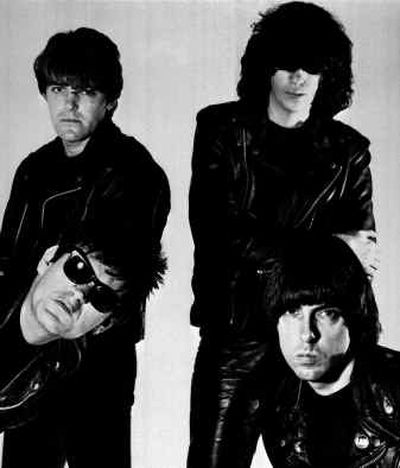Influential punk rocker Johnny Ramone dies at 55

LOS ANGELES – Johnny Ramone, the guitarist whose bursts of primitive punk energy helped the Ramones go from an obscure New York band to a reshaping force in rock ‘n’ roll, died Wednesday at his home in Los Angeles. He was 55.
Ramone, born John Cummings but known by the surname adopted by each of the punk group’s members, died in his sleep and surrounded by friends, according to his family. He had been battling prostate cancer for five years.
The Ramones were a potent and beloved force in punk rock, although their influence and acclaim came late in the game. The band, known for songs that were simple, short and frenetic, formed in 1974 in Forest Hills, N.Y., and their influence was immediate in the late 1970s underground music revolution of punk, but the members watched as other acts garnered the largest spotlight.
Inducted last year into the Rock and Roll Hall of Fame – ahead of the more celebrated Sex Pistols – and celebrated in a documentary film, “End of the Century,” now in theaters, the Ramones had to wait until most of their membership had died to be hailed by mainstream pop culture as a pioneering force. With Johnny’s death, only one member of the original quartet, drummer Tommy Ramone, is still alive.
With songs such as “I Wanna Be Sedated,” “Sheena is a Punk Rocker,” “Blitzkrieg Bop,” “Judy Is a Punk” and “Beat on the Brat,” the Ramones created an underground sensation in the summer of 1974 with their residency at CBGB, a scruffy club in lower Manhattan. Their fashion was bowl haircuts and ripped jeans, and their musical pedigree was equally tattered.
The band’s self-titled 1976 album, recorded for less than $7,000, was a definitive work, with 14 almost cartoonish songs they raced through in less than 30 minutes. The band toured incessantly, and their 1976 foray through Europe influenced much of the U.K. rock scene.
The band had started, famously, as a group of glue-sniffing delinquents who saw in music their only chance to escape a dead-end life. With Dee Dee, Joey and Tommy, the youngsters somehow exuded both urban fatalism and pure rock optimism. The band got its name from an alias that Paul McCartney had used to reserve hotel rooms under during the Beatles years.
Punk rock surged in popularity and the band continued to tour, but the headlines went more often to acts such as the Clash, who added complexity to the searing energy of the genre. The Ramones were a popular concert act, but their albums would come and go with little commercial impact.
By the 1990s, the hipness of the band and the success of the newer generations of artists who revered it led to a widening appreciation. In 1992, Spin magazine cited the band as one of the top seven rock acts of all time. Last year, an album of Ramones song covers was released featuring top bands, including U2 and Metallica.
Johnny Ramone essentially hung up his guitar in 1996 after the Ramones farewell tour and said often that he thought the band would be a footnote. “Six years later the Ramones are bigger than ever, have more friends and better friends, and everyone’s nice to me wherever I go,” he told the Los Angeles Times in 2003. “It’s weird; it’s nice. Better late than never … I’m very competitive and I want people to see us as one of the best bands, and when most people you talk to don’t even know who the hell you are, yeah, it never feels good.”
The Long Island-born Johnny Ramone was often described as a core force in the band’s run but also as a difficult personality. He told people his personality came across in the music — that the rough and fast edge would not be there if his worldview was a soft one.
In “End of the Century,” the new documentary, he also spoke to the Ramones emphasis on energy over craft. “I didn’t know how to play,” Johnny said. “I looked in the mirror. I put the guitar on and adjusted it to the height I thought was coolest. I started strumming down because I wanted to play fast. That’s how it started.”